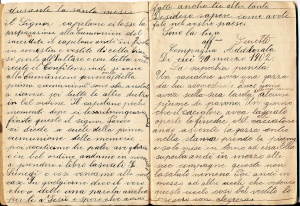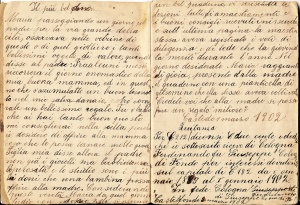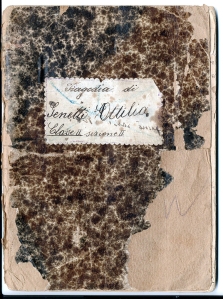
Allen Rizzi
Author and Blogger
Today we have an interesting and informative guest article by author, songwriter, genealogist and fellow Trentini American, Allen E. Rizzi. We feature two of Allen’s books in our Family Bookstore (you’ll find links for all of his books at the end of this blog post).
I follow Allen’s eclectic blog and as soon as I read this post, I knew it would be perfect for the Genetti Family Genealogy Project.
If you enjoy Allen’s insightful article, read more of Mr. Rizzi’s plethora of commentary or subscribe to his blog at: https://rizziallen.wordpress.com/
Here is Allen’s August 30th post in its entirety.
Tirolean Names by Allen Rizzi
I have always loved names, especially Tirolean surnames. Surnames were invented after first names ceased to distinguish various people in small villages and towns. Prior to the year 800, people usually only had given names in the Tirol. Hence, you find Johannes fu (or von) Dominicus to simply describe the birth of Johannes, son of Dominicus. It was a simple naming convention and it worked… for awhile.
Surnames were then used to distinguish between the various people having the same given name in any particular population center. They were often fashioned after the patriarch’s given name. Of the various Johannes living in one spot, the surname was added; perhaps Dominici to distinguish a particular Johannes who was descended from Dominicus. Surnames were always descriptive and were intended to differentiate for reasons of census and taxation.
But as populations grew, there were too many people of the same given name and same surname in any one location. Confusion once again reigned. In my native village of Cloz for example, there were many people named Giovanni Rizzi at any one time. What to do? In the Tirol, sopranomi (nicknames) were introduced.
Sopranomi were first used to distinguish people with identical names living in one population center or town. If there were too many Johannes Dominicis in one area, the sopronome helped to discern which Johannes Dominici was being named in any instance.
Sopranomi vary widely in the Tirol. Some are taken from physical characteristic, others from one’s occupation and still others from the patriarch of the family. I was, for example, born Picolo Alessandro di Eugenio Valentino Von Rizzi Regin. The last of this huge moniker is my soprnome, Regin. It derives from the fact that a very distant ancestor once worked in the court of Maria Teresa of Austria (regin = queen in our dialect) as a secretary. My grandmother’s sopranome was Segala, indicating that one of her ancestors was known for being born in a rye field. Sopranomi were mandatory for many years as populations in the Tirol grew. Both governments and local residents had to know who exactly was being referred to. Today, they are of little real importance although most families still carry them with pride as a cherished piece of their heritage. In fact in some villages, people are still known only by their sopranome rather than their surname.
But let’s turn our attention to those wonderful Tirolean surnames. Many simply mean “sons of” such as Michelini, Bertagnolli, Martinelli, Giuliani (sons of Michael, Umberto, Martin and Julian). Of all Tirolean surnames, this type is the most common. Hundreds of examples can be found, many ending in “i.” Sometimes surnames of German origin have been Italianized such as Gebardi (sons of Gebhart, which in turn means hardy and brave). Other Germanic surnames have survived intact such as Larcher (living among the larch ((tamarack)) trees), Mayrhofer (from the region of Mayrhof in Austria.) and Kirschbaumer (cherry grower).
Still other surnames are descriptive of physical characteristics such as my own surname Rizzi, which simply means “curly haired.” In my native village of Cloz in the Val di Non, there are only a few surnames: Angeli (Angels), Franch (free of taxation), Gembrini (born in December), Flor (flower), Floretta (little flower), Zanoni (sons of John), Canestrini (little jars), Rauzi (root harvesters) and of course Rizzi.
Yet other surnames describe a trade or residence location. These are commonly found in both the Italian and German rooted languages. Some examples of trade referenced surnames include Zadra (weavers), Kofler (land surveyors), Geiser (goat herders), Sartori (tailors), Mitterer (carpenters), Preti (priests), and Zucali (pumpkin growers).
Examples of residence referenced surnames include Aufderklamm (living on the gorge), Plattner (living on level fields), Egger (living on the corner), DalRi (living near the river), DallaValle (living in the valley), Dalsass (living among the stones), Dalpiaz (living in the piazza), Clauser (from Cloz) and Ausserer (living outside the edge of town).
Sometimes, surnames are super obvious. I recently saw a funeral notice for a woman whose maiden name was Carotta (carrot) and whose married name was Stanchina (a little tired). I joked that she had passed away as a “carrot who was a little tired.” Actually, the woman lived to 103 years; not bad for a tired old vegetable!
In all cases Tirolean surnames actually mean something, even if it has been lost in ancient local dialect. That’s where genealogists like me come in. Many of us are able to trace the exact origin of surnames, even if those words or names no longer exist or have been drastically changed.
Tirolean names – They are interesting and most have a very long and traceable history. If you would like your Tirolean name researched, please get in touch with me. Genealogy is what I do. You may contact me here: http://www.allenrizzi.weebly.com

About Allen Rizzi: Writer with over 55 years professional experience including non-fiction, music, and corporate analytical writing. Author of eight books available through Amazon.com. Additional expertise as a photographer. Specialties: Historical non-fiction, fiction, nostalgia, public profiles, biographies, contracts, and documentary writing in English, Italian, and German. Recent articles have appeared in The Numismatist, NOS Magazine, and on the internet. Music composition and lyrics have been a specialty since 1974. Songwriting credits include over 150 songs (1974-present): Easy Listening, Country, Rock, and R&B. Currently completing a book in German and writing music and lyrics for recording artists in the United States and Europe. Cogito, ergo scribo….
For more info, please see Allen Rizzi’s LinkedIn account at:
https://www.linkedin.com/in/allen-rizzi-59ab5420/
Books by Allen Rizzi
Click on book for Amazon link:














 Since many short stories are a part of Tillie’s 1902 Notebook, I thought this would be an appropriate post to mention the ancestral history of Tyrolean folklore and the custom of “Filò” (pronounced fee-lò).
Since many short stories are a part of Tillie’s 1902 Notebook, I thought this would be an appropriate post to mention the ancestral history of Tyrolean folklore and the custom of “Filò” (pronounced fee-lò).




















